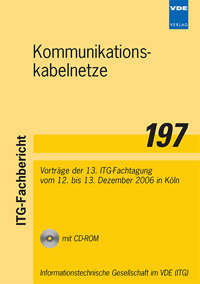Cabling System Calculation using Transmission Matrices
Konferenz: Kommunikationskabelnetze - 13. ITG-Fachtagung
12.12.2006 - 13.12.2006 in Köln, Germany
Tagungsband: Kommunikationskabelnetze
Seiten: 11Sprache: EnglischTyp: PDF
Persönliche VDE-Mitglieder erhalten auf diesen Artikel 10% Rabatt
Autoren:
Oehler, Albrecht M. (Hochschule Reutlingen)
Schicketanz, Dieter W. (München)
Inhalt:
Limits for channels and permanent links for customer premises are defined in the cabling standards ISO/IEC 11801 and CENELEC 50173. In the past the so called “component up approach” was used in most cases to calculate transmission limits and margins of these channels and permanent links. For NEXT and ELFEXT (and related PS items) the assumption of “Voltage sum” was used. This means that the distributed NEXT of a cable was summed in phase to the NEXT of another cable or connector. For the permanent link limit the consolidation point was neglected, assuming that the components would have sufficient margins to cope with this. Return loss could not be calculated with this component up approach and the channel limit was adapted to real measurements. For the permanent link limit 2 dB were added to the channel limit even if adding a patchcord sometimes goes the other way around. ELFEXT (or the new definition ACR-F) has so much margin that any theory would fit. Up to 100 MHz this was a suitable approach. Up to 250 MHz it started to show discrepancies. For the new proposed classes EA (up to 500 MHz) and FA(up to 1000 MHz) this approach is definitely not suitable any more. At 500 MHz the wavelength in air is 60 cm. To make the assumptions above the components should be smaller than 1/10 of the wavelength multiplied by the ε of the component (for connectors this is less then 2 cm). As this it not the case any more, the theory has to be revised. That is why attempts were made to calculate the limits for component up approach but adding “assumed margins” to cope for real cases assuming also “power sum”. But return loss and FEXT are still open, and second order effects are neglected.


